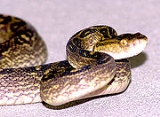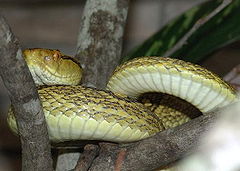
Trimeresurus flavoviridis
Encyclopedia
- Common names: habu, Okinawa habu, Okinawan habu, Kume Shima habu.
Trimeresurus flavoviridis is a venomous
Venomous snake
"Poisonous snake" redirects here. For true poisonous snakes, see Rhabdophis.Venomous snakes are snakes which have venom glands and specialized teeth for the injection of venom...
pitviper
Crotalinae
The Crotalinae, commonly known as "pit vipers" or crotaline snakes, are a subfamily of venomous vipers found in Asia and the Americas. They are distinguished by the presence of a heat-sensing pit organ located between the eye and the nostril on either side of the head...
species
Species
In biology, a species is one of the basic units of biological classification and a taxonomic rank. A species is often defined as a group of organisms capable of interbreeding and producing fertile offspring. While in many cases this definition is adequate, more precise or differing measures are...
found in Japan
Japan
Japan is an island nation in East Asia. Located in the Pacific Ocean, it lies to the east of the Sea of Japan, China, North Korea, South Korea and Russia, stretching from the Sea of Okhotsk in the north to the East China Sea and Taiwan in the south...
in the Ryukyu Islands
Ryukyu Islands
The , also known as the , is a chain of islands in the western Pacific, on the eastern limit of the East China Sea and to the southwest of the island of Kyushu in Japan. From about 1829 until the mid 20th century, they were alternately called Luchu, Loochoo, or Lewchew, akin to the Mandarin...
. No subspecies
Subspecies
Subspecies in biological classification, is either a taxonomic rank subordinate to species, ora taxonomic unit in that rank . A subspecies cannot be recognized in isolation: a species will either be recognized as having no subspecies at all or two or more, never just one...
are currently recognized.
Description

Scalation includes 35 (sometimes 31, 33, 37 or 39) rows of dorsal scales
Dorsal scales
In snakes, the dorsal scales are the longitudinal series of plates that encircle the body, but do not include the ventral scales.When counting dorsal scales, numbers are often given for three points along the body, for example 19:21:17...
at midbody, 217-239 ventral scales
Ventral scales
In snakes, the ventral scales are the enlarged and transversely elongated scales that extend down the underside of the body from the neck to the anal scale. When counting them, the first is the anteriormost ventral scale that contacts the paraventral row of dorsal scales on either side...
, 72-95 subcaudal scales
Subcaudal scales
In snakes, the subcaudal scales are the enlarged plates on the underside of the tail. These scales may be either single or divided and are preceded by the anal scale....
and 7-10 supralabial scales
Supralabial scales
In reptiles, the supralabial scales, also called upper-labials, are those scales that border the mouth opening along the upper jaw. They do not include the median scale . The term labial originates from Labium , which refers to any lip-like structure...
. The crown is covered with small scales.
The color pattern consists of a light olive of brown ground color overlaid with elongated dark green or brownish blotches. The blotches have yellow edges, sometimes contain yellow spots, and frequently fuse to produce wavy stripes. The belly is whitish with dark coloring along the edges.
Common names
Habu, Okinawa habu, yellow-green tree viper, Okinawan habu, Kume Shima habu (for T. f. tinkhami).Geographic range
Found in JapanJapan
Japan is an island nation in East Asia. Located in the Pacific Ocean, it lies to the east of the Sea of Japan, China, North Korea, South Korea and Russia, stretching from the Sea of Okhotsk in the north to the East China Sea and Taiwan in the south...
in the Ryukyu Islands
Ryukyu Islands
The , also known as the , is a chain of islands in the western Pacific, on the eastern limit of the East China Sea and to the southwest of the island of Kyushu in Japan. From about 1829 until the mid 20th century, they were alternately called Luchu, Loochoo, or Lewchew, akin to the Mandarin...
, including Okinawa
Okinawa Island
Okinawa Island is the largest of the Okinawa Islands and the Ryukyu Islands of Japan, and is home to Naha, the capital of Okinawa Prefecture. The island has an area of...
and the Amami Islands
Amami Islands
The are a group of islands that is part of the Satsunan Islands, which are then part of the Nansei Islands. The islands are part of Kagoshima Prefecture, in the Kyūshū region of Japan...
. The type locality given is "Amakarima Island (one of the Loo-Choo group)" (= Keramashima, Ryukyu Islands).
Common on the larger volcanic islands, but not present on the smaller coral islands.
Habitat
Often reported in the transition zone between palm forest and cultivated fields. Found on rock walls and in old tombs and caves.Behavior
Terrestrial and mostly nocturnal, it often enters homes and other structures in search of rats and mice. Bold and irritable, it can strike quickly and has a long reach.Reproduction
OviparousOviparity
Oviparous animals are animals that lay eggs, with little or no other embryonic development within the mother. This is the reproductive method of most fish, amphibians, reptiles, all birds, the monotremes, and most insects, some molluscs and arachnids....
, it is one of the few pitvipers
Crotalinae
The Crotalinae, commonly known as "pit vipers" or crotaline snakes, are a subfamily of venomous vipers found in Asia and the Americas. They are distinguished by the presence of a heat-sensing pit organ located between the eye and the nostril on either side of the head...
that lays eggs. Mating takes place in early spring and up to 18 eggs are laid in mid-summer. The hatchlings, which emerge after an incubation period of 5-6 weeks, are 10 inches (25 cm) in length and look the same as the adults.
Predators
To reduce the population on the island of Okinawa, the small Indian mongoose, Herpestes javanicus, was introduced in 1910. Although the effects of this introduction have not been studied, in other such cases the negative effects on species of native birds, mammals, and herpetofauna have been a source of concern for wildlife managers.Venom
The incidence of snakebite in the Amami IslandsAmami Islands
The are a group of islands that is part of the Satsunan Islands, which are then part of the Nansei Islands. The islands are part of Kagoshima Prefecture, in the Kyūshū region of Japan...
is 2 per 1,000 people, which is very high. The venom of this species is of high toxicity, yet the fatality rate is only 3%. If a bite victim receives medical care promptly, bites are not life-threatening. However, 6-8% do suffer permanent disability.
Brown (1973) gives values of 3.1, 4.3, 3.7, 2.7, 3.7, 3.8 mg/kg IV
Intravenous therapy
Intravenous therapy or IV therapy is the infusion of liquid substances directly into a vein. The word intravenous simply means "within a vein". Therapies administered intravenously are often called specialty pharmaceuticals...
, 5.1 mg/kg IP and 6.0, 3.5-5.0, 4.5 mg/kg SC for toxicity.
Exploitation
On the island of Okinawa, this species is heavily collected, primarily for use in habu sake. Actually not sake, but a stronger liquor called awamoriAwamori
Awamori is an alcoholic beverage indigenous to and unique to Okinawa, Japan. It is made from rice, and is not a direct product of brewing but of distillation ....
, it is alleged to have medicinal properties. The production includes the snakes in the fermentation process and it is sold in bottles that may or may not contain the body of a snake.

